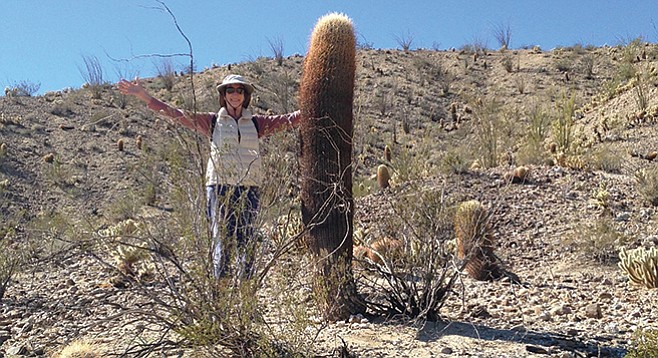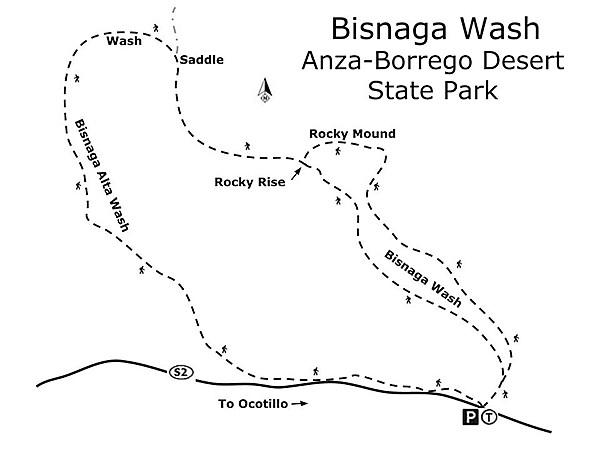 Facebook
Facebook
 X
X
 Instagram
Instagram
 TikTok
TikTok
 Youtube
Youtube

Begin the hike from the parking area and follow the wash veering to the northwest, keeping the hills on your left. Bisnaga Wash is a wide wash with gradual elevation gain, ending in a narrow rocky rise. Walking up the rise is difficult due to picking your way around boulders and cacti, so you can at this point either turn around or cross over the mound of sand rocks to the right (southeast) to return on the other side of the wash following alongside the hills that border the wash. If you have GPS, you may walk to the top of the rise and over a saddle to another wash descending to the left into Bisnaga Alta Wash. Otherwise, this is an out-and-back hike.
Bordering the wash are hills dotted with many kinds of cacti, the most notable being the barrel cactus. The name of the wash, “Bisnaga,” is Spanish for barrel cactus. The best time of year to explore the wash is March and April because this is when most of the cacti are in bloom. Temperature-wise, you can hike comfortably from November through April.
Washes are fun to walk in because they are a natural, well-marked wide path, allowing for all kinds of exploration. In a good rain year, flowers in a wash are plentiful, especially after the wash narrows. Many of them grow in the shelter and shade of cactus or creosote, lavender or jojoba bushes.
You may see wildlife such as snakes, lizards, rabbits, tarantulas, rats, tortoises, birds, and antelope squirrels. Look for their tracks in the sand. There is a lot of activity in the cooler mornings and evening hours.
If you look carefully, you may be able to spot an occasional cactus wren’s nest in the cholla cactus branches; the nests are the shape of a rounded football with a hole on the side. At the base of a cholla cactus, you may see nests of rats and mice; these look like a pile of sticks, desert plants, and fibers.
The most plentiful plants are cacti. The bisnaga or barrel cactus is a fat barrel-shaped cactus that has accordion-like vertical creases and is covered with stout hooked yellow to bright red spines. The spines are dense and protect the cactus from the strong sunshine. The cacti do not branch and can reach a height of several feet. The tallest in this area was recorded to be ten feet tall; most average 4-5 feet. It’s fun to spy the tallest you can see and record it in a picture. The blooms are beautiful and showy. They make a yellow crown on the top of the cactus, also very photogenic. They actually lean toward the sun, so you will observe that many are leaning to the southwest. They have shallow roots and will fall over when they lean too much. That they are a source of water in an emergency is a myth; they contain a pulpy liquid that is not potable.
The ocotillo (Fouquieria splendens) is very noticeable cactus-like plant, as it is the tallest in the wash. They grow up to 30 feet tall, and have spiny gray-green woody stems which branch from the base. After a rain, short green leaves grow the length of the branches. From January to April, scarlet red tubular flowers bloom at the end of the branches that attract hummingbirds and photographers. As you drive through Ocotillo, notice that some fences are made of ocotillo stems.
The teddy bear cholla is the cactus to beware of. It is covered with spines and has joints that break off very easily, so you want to not only beware of getting too close to it but also to watch the ground for all the broken-off joints, sometimes called “cholla balls,” as many are round. If you aren’t careful, you may have several attached to your shoes, your skin, or your clothes. Ouch! The easiest and least painful way to remove them is to take a comb and pull them out. They are called “teddy bear” because the appearance of the many spines looks like fur and when it’s very hot and dry, they turn brown like a teddy bear. The blossoms are greenish white, showing up in late March.
Other cacti that can be found in plentiful numbers are diamond cholla, gold cholla, buckhorn cholla, beaver tail cactus with bright magenta flowers, hedgehog cactus clusters, and fishhook cactus. The fishhook cactus is always a treasure to find. It is a delicate, small 6” cactus covered with little fishhook shaped spines usually found in the shade of rocks. It has a yellow crown of blossoms and a bright red fruit.
The beaver tail cactus is a benign-looking cactus with flat rounded pads that look spineless. Beware not to touch because minute spiny hairs will be deposited in your skin and to remove them requires a magnifying glass — a painful experience. They are related to the prickly pear cactus.
Return to the car with fond memories of all you have seen in this beautiful wash!
BISNAGA WASH (Anza-Borrego Desert State Park)
Enjoy many kinds of cacti, flowers, and animal tracks.

Directions: (Ocotillo) Take I-8E to exit 89. Turn left onto N. Imperial Highway, which becomes S-2. Continue north for 28 miles. Look for the sign “Bisnaga Wash” on the right after mile marker 38 and before mile marker 37. Hiking length: 3-4 miles. Allow 3 hours hiking time. Difficulty: Easy to moderate. Bring plenty of water, wear long pants, hard-toed shoes with thick soles, and a comb in case of contact with the teddy bear cacti. No dogs allowed. No facilities.


Begin the hike from the parking area and follow the wash veering to the northwest, keeping the hills on your left. Bisnaga Wash is a wide wash with gradual elevation gain, ending in a narrow rocky rise. Walking up the rise is difficult due to picking your way around boulders and cacti, so you can at this point either turn around or cross over the mound of sand rocks to the right (southeast) to return on the other side of the wash following alongside the hills that border the wash. If you have GPS, you may walk to the top of the rise and over a saddle to another wash descending to the left into Bisnaga Alta Wash. Otherwise, this is an out-and-back hike.
Bordering the wash are hills dotted with many kinds of cacti, the most notable being the barrel cactus. The name of the wash, “Bisnaga,” is Spanish for barrel cactus. The best time of year to explore the wash is March and April because this is when most of the cacti are in bloom. Temperature-wise, you can hike comfortably from November through April.
Washes are fun to walk in because they are a natural, well-marked wide path, allowing for all kinds of exploration. In a good rain year, flowers in a wash are plentiful, especially after the wash narrows. Many of them grow in the shelter and shade of cactus or creosote, lavender or jojoba bushes.
You may see wildlife such as snakes, lizards, rabbits, tarantulas, rats, tortoises, birds, and antelope squirrels. Look for their tracks in the sand. There is a lot of activity in the cooler mornings and evening hours.
If you look carefully, you may be able to spot an occasional cactus wren’s nest in the cholla cactus branches; the nests are the shape of a rounded football with a hole on the side. At the base of a cholla cactus, you may see nests of rats and mice; these look like a pile of sticks, desert plants, and fibers.
The most plentiful plants are cacti. The bisnaga or barrel cactus is a fat barrel-shaped cactus that has accordion-like vertical creases and is covered with stout hooked yellow to bright red spines. The spines are dense and protect the cactus from the strong sunshine. The cacti do not branch and can reach a height of several feet. The tallest in this area was recorded to be ten feet tall; most average 4-5 feet. It’s fun to spy the tallest you can see and record it in a picture. The blooms are beautiful and showy. They make a yellow crown on the top of the cactus, also very photogenic. They actually lean toward the sun, so you will observe that many are leaning to the southwest. They have shallow roots and will fall over when they lean too much. That they are a source of water in an emergency is a myth; they contain a pulpy liquid that is not potable.
The ocotillo (Fouquieria splendens) is very noticeable cactus-like plant, as it is the tallest in the wash. They grow up to 30 feet tall, and have spiny gray-green woody stems which branch from the base. After a rain, short green leaves grow the length of the branches. From January to April, scarlet red tubular flowers bloom at the end of the branches that attract hummingbirds and photographers. As you drive through Ocotillo, notice that some fences are made of ocotillo stems.
The teddy bear cholla is the cactus to beware of. It is covered with spines and has joints that break off very easily, so you want to not only beware of getting too close to it but also to watch the ground for all the broken-off joints, sometimes called “cholla balls,” as many are round. If you aren’t careful, you may have several attached to your shoes, your skin, or your clothes. Ouch! The easiest and least painful way to remove them is to take a comb and pull them out. They are called “teddy bear” because the appearance of the many spines looks like fur and when it’s very hot and dry, they turn brown like a teddy bear. The blossoms are greenish white, showing up in late March.
Other cacti that can be found in plentiful numbers are diamond cholla, gold cholla, buckhorn cholla, beaver tail cactus with bright magenta flowers, hedgehog cactus clusters, and fishhook cactus. The fishhook cactus is always a treasure to find. It is a delicate, small 6” cactus covered with little fishhook shaped spines usually found in the shade of rocks. It has a yellow crown of blossoms and a bright red fruit.
The beaver tail cactus is a benign-looking cactus with flat rounded pads that look spineless. Beware not to touch because minute spiny hairs will be deposited in your skin and to remove them requires a magnifying glass — a painful experience. They are related to the prickly pear cactus.
Return to the car with fond memories of all you have seen in this beautiful wash!
BISNAGA WASH (Anza-Borrego Desert State Park)
Enjoy many kinds of cacti, flowers, and animal tracks.

Directions: (Ocotillo) Take I-8E to exit 89. Turn left onto N. Imperial Highway, which becomes S-2. Continue north for 28 miles. Look for the sign “Bisnaga Wash” on the right after mile marker 38 and before mile marker 37. Hiking length: 3-4 miles. Allow 3 hours hiking time. Difficulty: Easy to moderate. Bring plenty of water, wear long pants, hard-toed shoes with thick soles, and a comb in case of contact with the teddy bear cacti. No dogs allowed. No facilities.
Comments